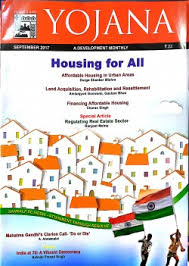(HOT) UPSC Current Affairs 2025 PDF
NEW! The Gist (NOV-2025) | E-BOOKS
(Download) Yojana Magazine Free PDF Archive : September-2017
(Download) Yojana Magazine Free PDF Archive : September-2017
CONTENTS
- Affordable Housing in Urban
- Areas
- Durga Shanker Mishra - 7
- Land Acquisition, Rehabilitation
- and Resettlement
- Amlanjyoti Goswami
- Gautam Bhan-15
- Financing Affordable Housing
- Charan Singh - 20
Special Article
- Regulating Real Estate Sector
- Ranjeet Mehta - 25
- Green Technologies in
- Affordable Housing
- Yashkumar Shukla - 28
- Housing the Poor in Smart
- Cities
- Usha P Raghupathi - 33
- do you know?
- cooperative housing movement
- in India - 48
- Infrastructure Requirements
For Housing for All
- Krishna Dev - 37
- Building durable and quality
- houses in Rural Areas
- Sameera Saurabh
- Rahul Singh - 43
- sankalp se siddhi - attainment
- through resolve - 52
- Mahatma Gandhi’s Clarion Call
- “Do or Die”
- A Annamalai - 54
Focus
- India at 70: A vibrant democracy
- Balmiki Prasad Singh - 57
- Development Roadmap-50
Aroof over one's head is a dream that every human being aspires for. While the rich and famous create palatial abodes for themselves, the poor man tries to buildhimself and his family a shelter be it only a plastic tent.
Housing, at one time was never an issue in the Indian context. The joint family system meant that there was one house for the entire family and all the family members lived in the family home. The trend of migration to cities for jobs first raised the issue of a house for a family. The advent of the nuclear family system further exacerbated the situation with parents and children living away from each other. Rising concentration of people in urban areas also resulted in an increase in the number of people living in slums and squatter settlements. According to 2011 census, the urban population of India increased by 91 million over a period of 10 years. The census projected housing shortage at 18.78 million in the beginning of 2012 with majority of it coming from economically weaker sections (EWS) or Low Income Groups (LIG).
Affordable housing has, thus, become one of the biggest challenges of the present times. Planning for a home has become imperative for the younger generation today who are often forced to begin their career with the quest for a permanent home for themselves. Skyrocketing prices of land and real estate in urban areas have made houses unaffordable. Ever rising rents, fleecing builders, unapproved land use, sub standard building material etc have all widened the gap between supply and demand.
It is in such situations that the Government regulations play an important role. While the Land Acquisition, Rehabilitation and Resettlement Bill ensured proper and justified use of the land for various purposes, the Real Estate (Regulation and Development) Act was introduced by the government to protect interests of home buyers. Pradhan Mantri Awas Yojana – Housing for All Urban has been introduced to solve the housing problem of the Indian middle, lower middle class and below poverty level class of its citizens. PMAY-G aims at providing a pucca house, with basic amenities, to all households living in kutcha and dilapidated houses, by 2022. On the financing front, while National Housing Bank regulates housing finance companies, RBI regulates commercial banks and partially cooperative banks. The Credit linked subsidy schemes have facilitated financing of houses even for those who could otherwise not afford them.
Infrastructure is another important dimension of housing. Adequate infrastructure facilities like roads, metro trains, schools, hospitals, shopping areas and children's play areas are a must for making “Housing for all by 2022” a success. Use of durable and environment friendly material in construction is equally important in today’s scenario. A design needs to be such that it ensures that the house withstands the ravages of time and nature. Green technology can make the house environment friendly and also obviate the necessity to use artificial coolers in the summer and heaters in the winter. Smart cities Mission and Atal Mission for Rejuvenation and Urban Transformation (AMRUT) aim to address these issues by promoting cities that provide core infrastructure and give the citizen a clean and sustainable environment and also address issues of improved quality of services.
Click Here to Download Yojana Magazine September-2017
Courtesy : Yojna Magazine


